Tips To Quickly Rank High In SEO So That Google Sends You Traffic
Publishers are constantly looking for ways to make their content rank higher in SEO; meaning having their content get more traffic from Google searches. For a publisher, there are few things more satisfying than nailing the SEO on a new article so well that it ranks immediately for a meaningful keyword.
While most publishers know that seasoned and mature content is more likely to rank higher as it gains more exposure, many don’t know why some of their new content ranks immediately and other articles seemingly never make it.
Today, I will cover three topics that will help you create high-ranking content quickly using some proven SEO techniques:
-
- How to pick topics to write about and how to write about them to rank fast
- How to format your content for the best chances of ranking quickly
- What additions will help your content rank higher long-term
You can watch me go through these steps in one of our Ezoic Explains videos, or read through my step-by-step process below.
If you’re new to data-driven keyword research, check out this article on getting started with keyword research.
What is a rich result or rich snippet in Google?
Rich results, or rich snippets, are search results that provide ‘snippets’ of information without requiring a user to click on a specific link. They’re what you see at the top of search results, especially in response to questions. For example, look at this search for ‘who is Abraham Lincoln.’
Most of you are familiar with Google’s Knowledge Graph — and may not love that it could be stealing your visitors — but it also gives you a secret weapon to getting content to rank faster!

The box at the top is often called ‘position 0’ and provides a bit of basic information about Abraham Lincoln. On the side, we have a little bit more information about him, like his hometown, children, and party. This ‘People also ask’ section is also an example of rich results.
Below, I’m going to go over how to quickly rank by optimizing your new content to show up in these rich results. As in most examples, I will use injuryhealthblog.com as the guinea pig (this tiny site I beat up a lot on this blog). I will also be using SEMrush as my keyword research tool, though Google does provide this information for free — which I’ll also share how to access. Moz also has similar tools.
How do I pick which keyword to rank high in SEO for?
To begin acquiring rich snippets, you first need to know what keyword you would like to rank for. So how do you choose?
- By selecting a topic that is you can ask questions about.
- Ensuring the topic has some rich results for queries about it already
- Using an SEO tool or Google itself to research related keywords.
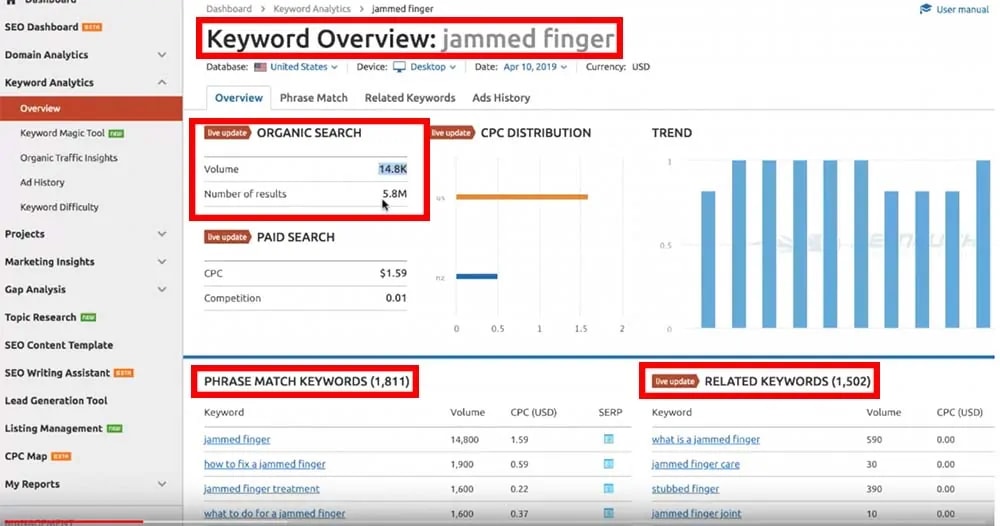
We’ve talked about choosing keywords before, like how you can use keywords to boost traffic to your previous content. The same sort of tactics can be used for new content as well.
Since I am writing for my injury blog, I am going to try to rank for ‘jammed finger.’
This is a great keyword choice because there are seemingly tons of potential queries about this topic and it gives me a lot of opportunities to answer many of them in my article.
How do I find related queries and keywords to rank for in Google?
If we look up the keyword ‘jammed finger’ in SEMrush, we can see all kinds of information on this specific keyword, including organic search volume and results, phrase match keywords, and related keywords.
As you can see, the organic search volume for jammed finger is high and it is a competitive keyword, so it is unlikely my content could rank quickly for this just keyword. However, there are plenty of longtail keywords associated with ‘jammed finger’ that I can acquire traffic quickly from through rich results.
Remember, 15% of all Google ‘s daily searches have never been searched before! You’re going after all the variation of your keyword in that group, plus some of the other long-tail terms that people commonly search on your subject.
If we look under Phrase Match Keywords, we can examine what people are actually typing into their search browsers that are related to my topic, ‘jammed finger.’
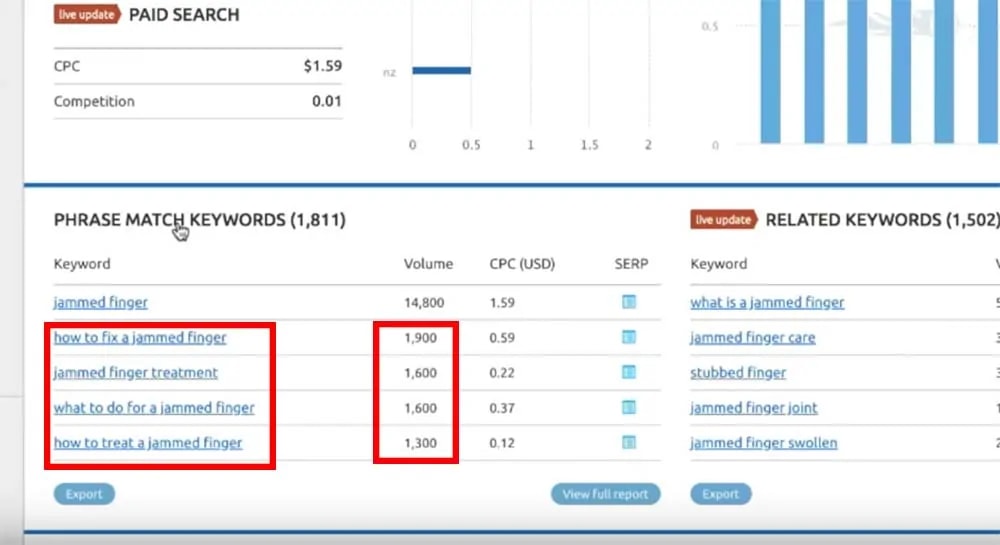
For this topic, a lot of these longtail keywords have to do with treatments, healing, symptoms, and the difference between jammed and broken.
If I am going to write an article about jammed fingers, it would be beneficial for me to create a post with information on these topics so I can rank for all of them.
In fact, each of these sub-topics and queries should be a section inside my article in which I try to specifically write content that would answer someone’s question. Google is great at understanding elements of HTML to pick out answers to questions in your content. This is how we can get those rich results fast.
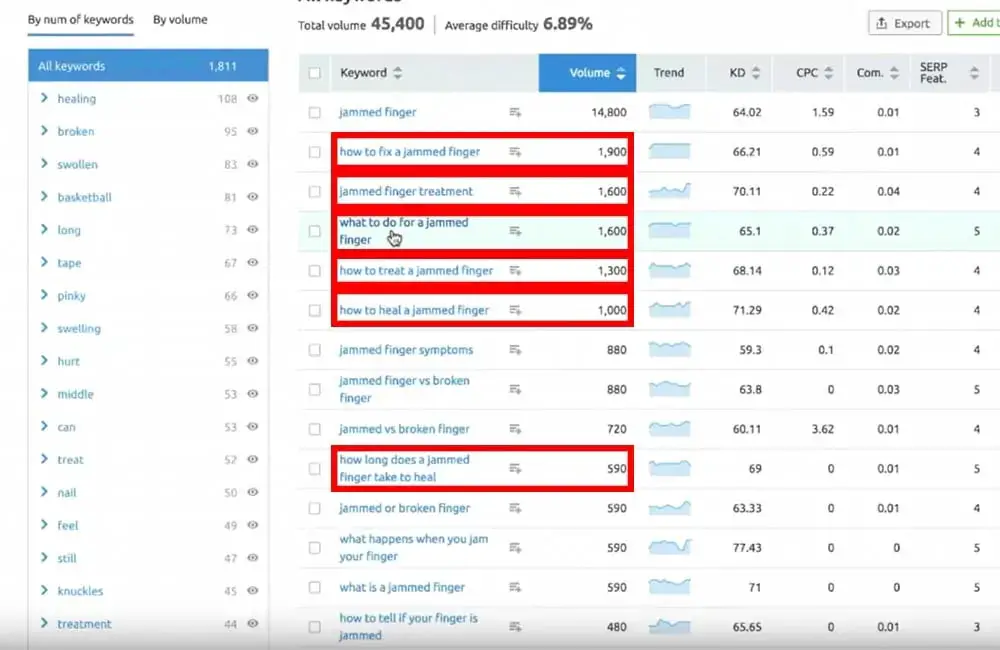
If you don’t have access to a paid SEO tool, you can type your keyword into Google search, enter a space at the end, and see additional search results. Google lacks some of the granular data and insights that you can get from paid tools but can give you a lot of ideas to get started with.
A lot of these inquiries are similar to what we saw in SEMrush — treatment, healing time, and symptoms (swollen). This information can also be used in addition to an SEO tool as well because it simply provides another level of insight that can give your content more high-ranking SEO opportunities.
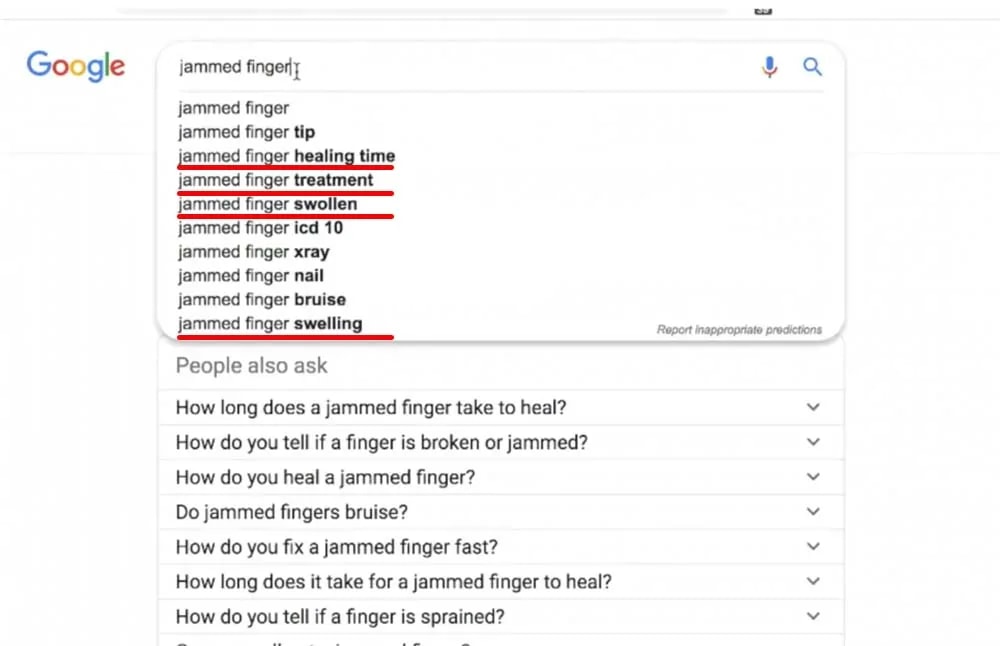
Now, here’s where we really start to build out the H2 headings, topics we will write about, and information we have to cover in the article.
We want to dig into the ‘People also ask’ results to determine what questions people specifically type in that may already have rich results.
Many of these are similar to the keywords/topics we found and the Google search queries — “how do you heal a jammed finger? How do you tell if a finger is broken or jammed? “
But, we also see some related questions we didn’t see in our other investigations, such as playing sports with a jammed finger, if jammed fingers bruise, and if you can pull out a jammed finger.
Digging into these “people also ask” yourself, you’ll find quickly that many of the rich snippets provided to these answers are from obscure sites, are poorly answering the question, or could be answered more clearly.
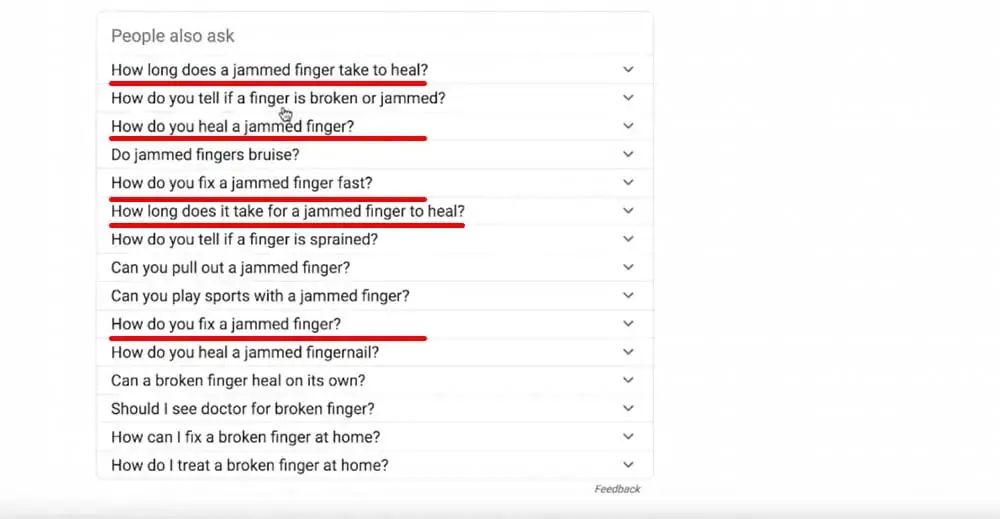
With this information, I am ready to begin writing the article. For this example, I will be using WordPress, but you can use whatever content creation system you currently use.
How do I use this to SEO my content to rank high?
You can organize and structure your content to optimize it for rich snippets. First, you need a good title.
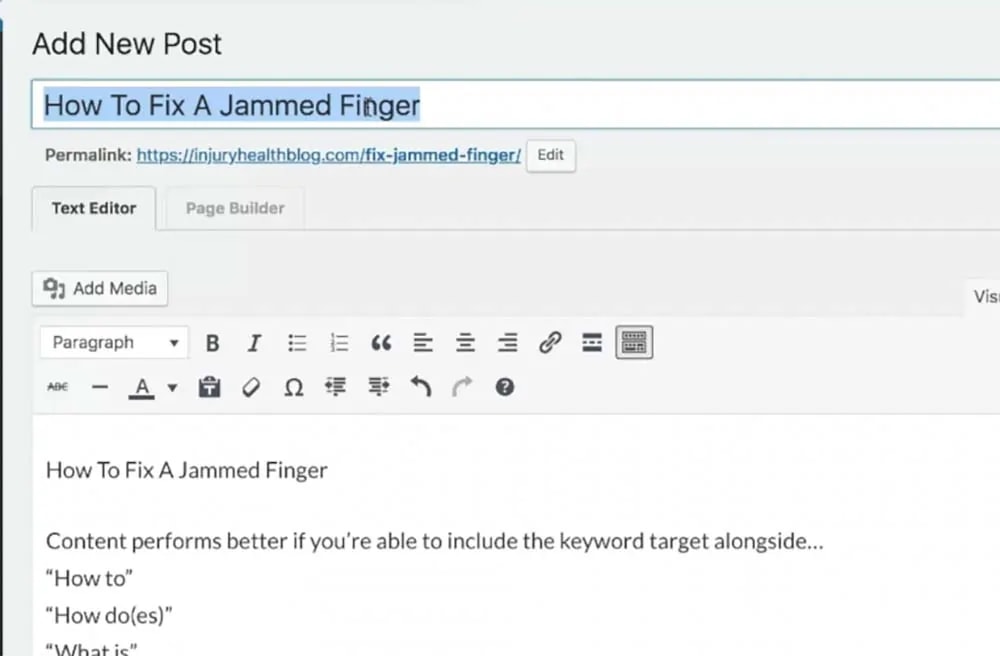
It is best to have a title that is some sort of popular general question about your topic, like ‘how to,’ ‘how does,’ ‘what is,’ or ‘what can,’ and then use the post to answer that question.
By making the title a question, you’re basically guiding search engines straight to your post and subtopics because you are specifically addressing a visitors inquiry.
If we look back on our SEMrush keyword information, the longtail keyword ‘how to fix a jammed finger’ does not have nearly as high of a search volume as ‘jammed finger,’ which means there is less competition. Yet, it is also a keyword that will not be difficult to rank for. So I’m going to the title this post ‘How To Fixed a Jammed Finger.’
In order for search engines to know what this post is about, I also want to make sure the title is some sort of <h> tag. Which <h> tag I choose will be determined on whether or not I have an image between the title and the first subheading. If I was not going to include an image, then I would want my first title within the actual post to be a <h1>.
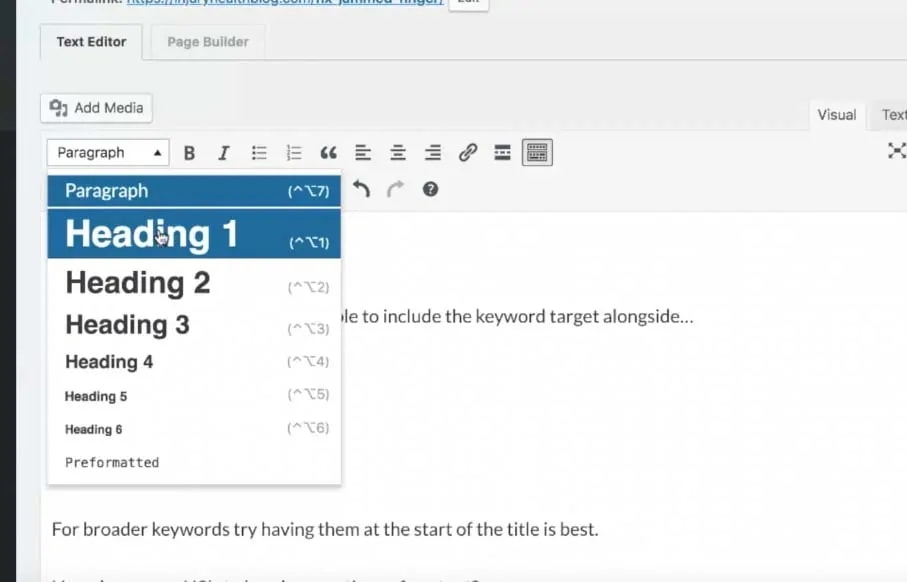
Since I will have an image between the main title and the first title of the actual post, I am going to make that first title a <h2>.
For an article with multiple subtopics like this, it can be beneficial to include bullets or numbered lists. This supports visitor engagement immediately and provides users with a brief of what topics will be covered. These subtopics should also be questions.
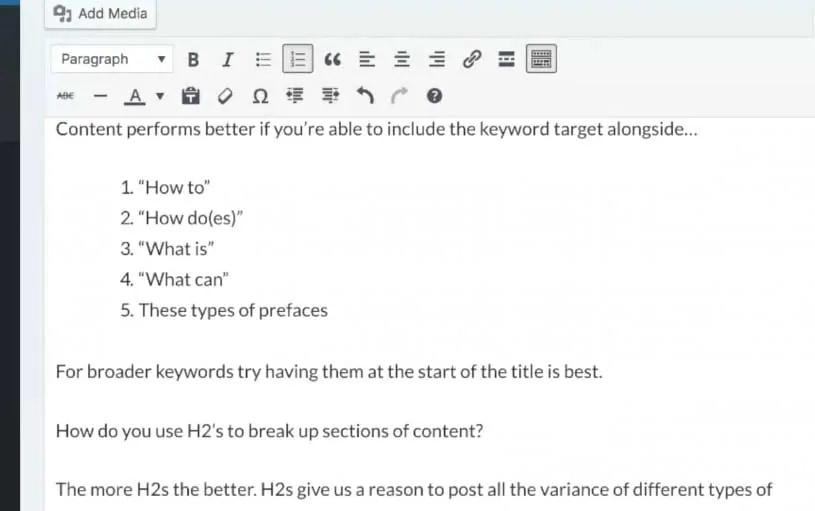
I will use a question we saw earlier in the drop-down boxes from the Google results and focus on providing an answer for that specific question.
Snippets are very taken from articles right below their <h2> tags. Making questions from your SEO tools, or the “people also ask” search results, your <h2> tags gives you a prime opportunity to write an answer to the question that is better than the one currently featured in a rich snippet or one that you think best provides what someone might be searching for.
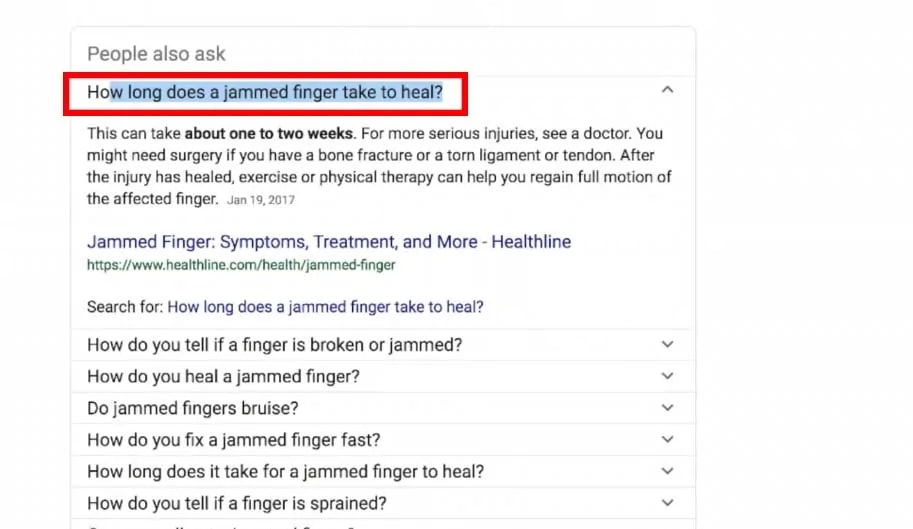
Search engines will serve whatever result is correct, succinct, and direct.
By posing a question, like ‘how long does a jammed finger take to heal?’, and making it a <h2>, I have a better chance of ranking for that rich result.
Answers directly under the <h2> tags are also more likely to appear as rich snippets if they are 1-4 sentences long. From there, you can add additional information related to the question directly below your opening sentences.
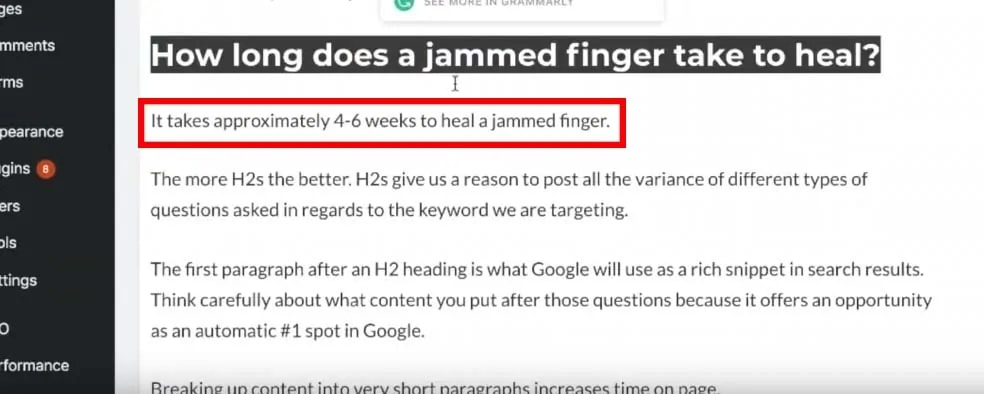
It’s best to break up content with these <h2> headers and to only answer questions that fall under the general theme of your article.
Since this post is about healing a jammed finger, good related questions and answers to include would be ‘how to fix a jammed finger,’ or ‘how to treat a jammed finger at home.’ As before, the first couple of sentences under your <h2> heading should be a succinct answer, a ‘snippet’ of information. In the following paragraphs, you can begin to answer more thoroughly.
What other SEO tips will help my content rank higher?
As we saw when we searched ‘who is Abraham Lincoln,’ the top rich snippets also included images.
Images are one of the additional items you can add to a post that support ranking, break up your content, and engage visitors.

When including an image, place it directly underneath the ‘snippet’ of your answer and paste the <h2> heading in the ‘Alt Text’ box. This tells Google and other search consoles my post answers that question, the answer is succinct, and includes media to support the answer.
Even if your answer isn’t featured as a rich snippet, your image might be. Your link will still be displayed at the top and if people click on the image, you’ll get the traffic!

Additionally, anytime you are able to include a bulleted or numbered list (beyond the one I placed at the beginning of the post), do so. It will also help Google recognize important lines of text and make rich snippets out of them.
Google often uses tables and bulleted or numbered lists in results. It’s something they look for because it easily summarizes information.
My goal, ultimately, is to make it extremely easy for Google to find my content for its rich snippets while still providing good content.

From here, I can edit the title tag and meta description to best fit the audience I’m trying to reach and then publish the post.
This isn’t as important as it used to be, but your title tag should definitely be phrased as a question if possible.
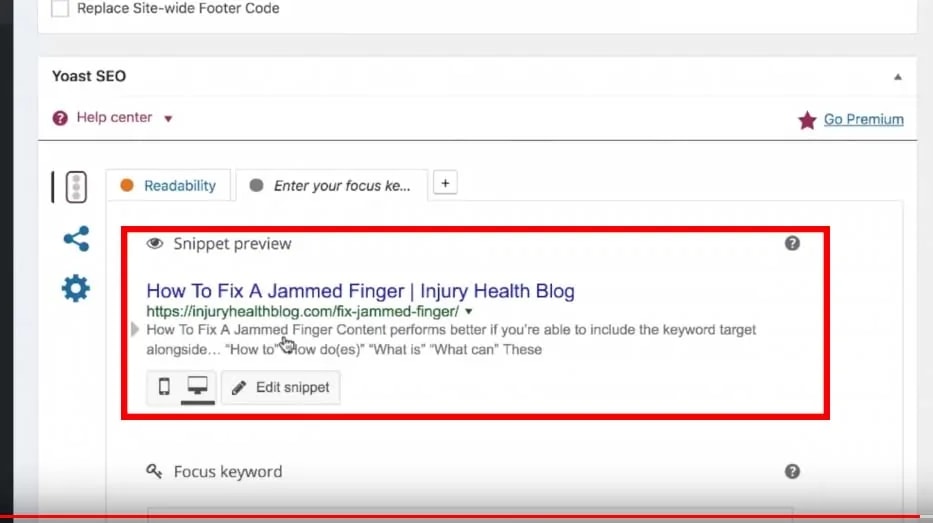
After the article has been posted for a bit of time, I will want to return to a tool like SEMrush and paste the post’s URL. From here, I can begin to see your post’s position, which queries I’m ranking for, and if I am ranking for queries I did not mean to.
If I am ranking for any unintended but relevant queries, I can go back into my content and add information to answer those queries so I can rank even higher. Since this article was just posted, it won’t have a ranking just yet.

How to rank higher in Google with modern SEO tips
This can seem a bit tedious but as you do this more frequently, you will naturally start to develop your content with these steps in mind.
Tactics like this are what push smaller publishers ahead of bigger publishers in SEO rankings. You may not have the size or backlinks, but you can tailor your content more pointedly. SEO tools like SEMrush also can make the process easier.
- Use an SEO tool like SEMrush — or Google itself— to search for a topic you would like to write about.
- Find a common theme amongst the queries (in this example, all the things that people would want to know about healing a jammed finger) for your content.
- Make your title and subheadings all questions you can answer (how to, what is, where is, etc.). Make sure all your subheadings are <h2> tags.
- Directly below the subheading, answer the question in 1-4 sentences. If you are going to include an image, place it directly under these sentences and make the image’s Alt tag the same as the subheading. From there, you can provide a more in-depth answer.
- Bulleted and numbered lists are helpful to both visitors and the search engine. If you’re able to, include them in your post.
- Edit the title tag and meta description to make your snippet look how you want it.
- After a while, return to your SEO tool and search the post’s URL. Check its performance, position, and any keywords you’re ranking for, intentionally or unintentionally. Augment your content if you rank for any unplanned keywords that are related to your article so you can rank even higher.
Also, kudos to anyone who noticed I used each step in this post to also create this content.
If you have any questions or comments, feel free to leave a note below and I’ll do my best to answer!


This tips is a banger I must say
It helped me alot and I know result will be out soon
I need more of this
This tips is a banger I must say
It helped me alot and I know result will be out soon
I need more of this
Love all the actionable steps in the post. Super helpful!
Love all the actionable steps in the post. Super helpful!
Thanks for the info, especially the part of h2 tags
Thanks for the info, especially the part of h2 tags
Great article and really well explained, Thank you.
Can I ask what editor you are using and is it a template within wordpress which shows the best practice? For example it’s written “is there a list of best practices” etc. I think this would be useful while I learn the seo side.
Great article and really well explained, Thank you.
Can I ask what editor you are using and is it a template within wordpress which shows the best practice? For example it’s written “is there a list of best practices” etc. I think this would be useful while I learn the seo side.
Should have a new article up on this soon.
Should have a new article up on this soon.
Thx for tips… righ now i have very hard site to positioning.. big competition and hard keywords.. Idk how start with this… better long tails at start? or just trying and waiting ?
One of the hardest keywords is “SEO” 🙂 i
Thx for tips… righ now i have very hard site to positioning.. big competition and hard keywords.. Idk how start with this… better long tails at start? or just trying and waiting ?
One of the hardest keywords is “SEO” 🙂 i
Best to focus on long-tail queries. Then, find all the other questions that are adjacent to that query and put those in the post as well. This will increase your chances of ranking for multiple long-tail keywords.
Best to focus on long-tail queries. Then, find all the other questions that are adjacent to that query and put those in the post as well. This will increase your chances of ranking for multiple long-tail keywords.
Most important thing is look for the competition. You will not rank for your jammed finger article. All the sites at the top are strong.
Most important thing is look for the competition. You will not rank for your jammed finger article. All the sites at the top are strong.
SEO ranking is very important part of website growth in Google. You shared this information is really helpful for me. I am very impressed from this blog. Thanks!
SEO ranking is very important part of website growth in Google. You shared this information is really helpful for me. I am very impressed from this blog. Thanks!
These are million dollar tips. My worry, however, is that Google keep updating their algorithm. And this makes all your past hardwork become failure. How can one prevent THIS from occurring?
These are million dollar tips. My worry, however, is that Google keep updating their algorithm. And this makes all your past hardwork become failure. How can one prevent THIS from occurring?
WOW, really awesome post thank you, Whitney, for sharing such a great post it’s helped me a lot
WOW, really awesome post thank you, Whitney, for sharing such a great post it’s helped me a lot
Very informative, but I’m having issues structuring content in my shopify store. It appears that shopify is not seo friendly.
Very informative, but I’m having issues structuring content in my shopify store. It appears that shopify is not seo friendly.
That is the struggle with SEO–things are constantly changing, and changing faster than ever before. Unfortunately, there is no easy way to make sure your website will triumph the same way through every Google algorithm change. There are some fundamental things you can do to ensure that no matter the algorithm update, your content will likely still perform well:
Quality content: make sure your content is unbiased/presents both sides, has no spelling or grammatical errors, has media/pictures/graphics that help break up content and give a visual to what you’re discussing; that your website is optimized for speed and user engagement, is mobile-friendly and optimized; and that you’re on top of any regulation/compliance like GDPR or CPPA (going into effect in California January 1, 2020). There are, of course, many other things you can do to help with SEO, ranking, and traffic, but these are all good places to start.
Additionally, we have a few other blogs that go over how to write quality content that will earn more and some clever digital publishing strategies from some of our successful publishers. There are some pretty tried-and-true methods in these blogs and the last one has a writing guide for targeting search queries effectively:
https://www.ezoic.com/digital-publishing-strategies-that-worked/
https://www.ezoic.com/how-to-make-website-content-that-will-produce-higher-earnings/
https://www.ezoic.com/content-writing-guide-seo-increase-visitor-engagement/
I hope this helps! I’m glad you found this blog helpful.
That is the struggle with SEO–things are constantly changing, and changing faster than ever before. Unfortunately, there is no easy way to make sure your website will triumph the same way through every Google algorithm change. There are some fundamental things you can do to ensure that no matter the algorithm update, your content will likely still perform well:
Quality content: make sure your content is unbiased/presents both sides, has no spelling or grammatical errors, has media/pictures/graphics that help break up content and give a visual to what you’re discussing; that your website is optimized for speed and user engagement, is mobile-friendly and optimized; and that you’re on top of any regulation/compliance like GDPR or CPPA (going into effect in California January 1, 2020). There are, of course, many other things you can do to help with SEO, ranking, and traffic, but these are all good places to start.
Additionally, we have a few other blogs that go over how to write quality content that will earn more and some clever digital publishing strategies from some of our successful publishers. There are some pretty tried-and-true methods in these blogs and the last one has a writing guide for targeting search queries effectively:
https://www.ezoic.com/digital-publishing-strategies-that-worked/
https://www.ezoic.com/how-to-make-website-content-that-will-produce-higher-earnings/
https://www.ezoic.com/content-writing-guide-seo-increase-visitor-engagement/
I hope this helps! I’m glad you found this blog helpful.
The tip on adding content for keywords that I ranked for accidentally was really helpful to me. In most cases, when I add a section about the ‘accidental’ keywords, my ranking for that phrase effortlessly jump to page 1 or 2 (of cause if the competition is low, so I look for accidental keywords that have already made it to page 2 or 3)
The tip on adding content for keywords that I ranked for accidentally was really helpful to me. In most cases, when I add a section about the ‘accidental’ keywords, my ranking for that phrase effortlessly jump to page 1 or 2 (of cause if the competition is low, so I look for accidental keywords that have already made it to page 2 or 3)
Tips that you have mentioned in this article are really helpful & informative. I was just looking for such type of blog to rank my website high on google. Thank you for sharing…
Tips that you have mentioned in this article are really helpful & informative. I was just looking for such type of blog to rank my website high on google. Thank you for sharing…
It Is Very Helpful! I’m Glad I found This Blog
It Is Very Helpful! I’m Glad I found This Blog
Thank you for this wonderful guide. I recently started a new business blog and was looking for help to rank it on search engines. I found your article very helpful. I’ll implement these tips, hope it will work for me. Thanks for sharing.
Thank you for this wonderful guide. I recently started a new business blog and was looking for help to rank it on search engines. I found your article very helpful. I’ll implement these tips, hope it will work for me. Thanks for sharing.
This has been one of the solid guides I have read so far. Thank you
Also, Neil Patel mentioned about how adding a FAQ section in his latest blog post help him outrank Hubspot for Digital marketing.
I have implemented in some of my smaller niche sites and it works wonders.
This has been one of the solid guides I have read so far. Thank you
Also, Neil Patel mentioned about how adding a FAQ section in his latest blog post help him outrank Hubspot for Digital marketing.
I have implemented in some of my smaller niche sites and it works wonders.
A really awesome post thank you, Whitney. Thanks so much for sharing. It really does help me a lot.
A really awesome post thank you, Whitney. Thanks so much for sharing. It really does help me a lot.
In some niche, people usually don’t click anything as the featured snippet section gives away the result the needed automatically.
Eg. Searching for our country independence date, celebrity height, and stuff along those lines.
Anyway, really a detailed guide. Thanks for sharing.
In some niche, people usually don’t click anything as the featured snippet section gives away the result the needed automatically.
Eg. Searching for our country independence date, celebrity height, and stuff along those lines.
Anyway, really a detailed guide. Thanks for sharing.
Nice Article about how to quickly rank keywords in Google
Nice Article about how to quickly rank keywords in Google
Will you share the plugins you use for wordpress site. It will be really helpful.
Will you share the plugins you use for wordpress site. It will be really helpful.
Thanks so much for sharing this awesome guide. It really helps a lot especially for beginners like me.
Thanks so much for sharing this awesome guide. It really helps a lot especially for beginners like me.
Great post by the way. Is there any cheaper alternatives to SEMrush?
Great post by the way. Is there any cheaper alternatives to SEMrush?
Awesome post ezoic team. Not related to this post but what is the difference between ezoic and adsense? BTW, sorry if the question sounds dumb. I am new to this space.
Awesome post ezoic team. Not related to this post but what is the difference between ezoic and adsense? BTW, sorry if the question sounds dumb. I am new to this space.
Very different. Ezoic is a technology platform with lots of features. One of the most popular is Ad Tester which allows publishers to leverage ad networks, like AdSense, to optimize the delivery of ads on a website to improve UX and website revenue.
Very different. Ezoic is a technology platform with lots of features. One of the most popular is Ad Tester which allows publishers to leverage ad networks, like AdSense, to optimize the delivery of ads on a website to improve UX and website revenue.
This way with “people also ask” is my favorite. It’s nice to see that so many people use it. Thanks for the very useful post!
This way with “people also ask” is my favorite. It’s nice to see that so many people use it. Thanks for the very useful post!
Blogs have become another way of engaging and capturing leads for the purpose of converting them as a qualified lead.
Blogs have become another way of engaging and capturing leads for the purpose of converting them as a qualified lead.
Yeah it sure is tough getting your posts to rank these days! Most people end up giving up too but you really can’t because you could literally be just a few weeks away from starting to rank well and not even know it!
Thanks for the tips in your article as well!
Yeah it sure is tough getting your posts to rank these days! Most people end up giving up too but you really can’t because you could literally be just a few weeks away from starting to rank well and not even know it!
Thanks for the tips in your article as well!
Thanks for the tips and ideas to come up with great content and quick keyword ranking. I too was thinking of the same to push our blog site for more traffic and more revenue from adsense, since corona virus is the major discussion globally and we don’t know, what impact it could have to a business that customer would be reluctant to continue doing certain regular activities, which used to be our bread & butter. so it’s good to always have a passive income so that business still runs and you buy out time to run smoothly during the current challenges.
Thanks for the tips and ideas to come up with great content and quick keyword ranking. I too was thinking of the same to push our blog site for more traffic and more revenue from adsense, since corona virus is the major discussion globally and we don’t know, what impact it could have to a business that customer would be reluctant to continue doing certain regular activities, which used to be our bread & butter. so it’s good to always have a passive income so that business still runs and you buy out time to run smoothly during the current challenges.